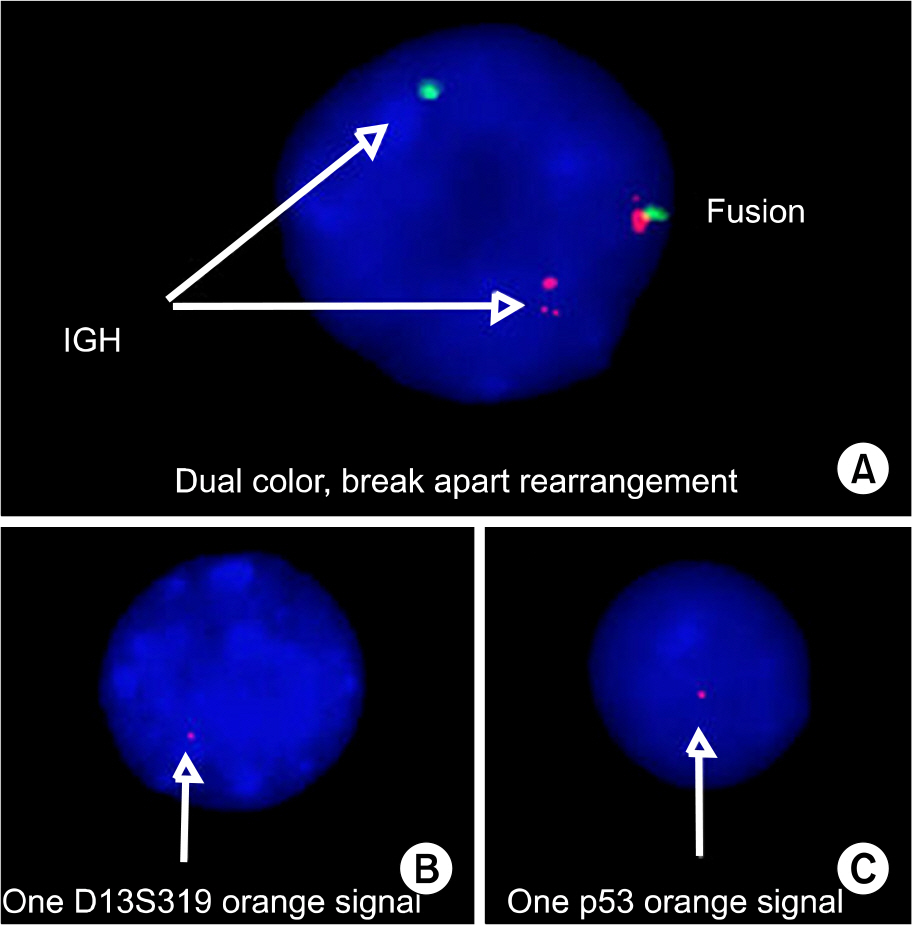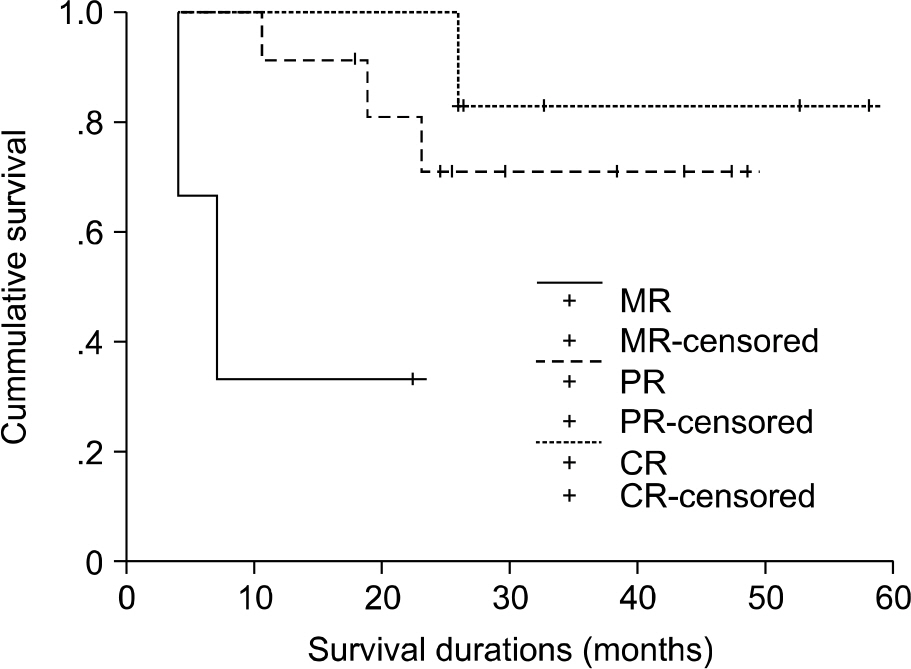Korean J Hematol.
2009 Mar;44(1):14-21. 10.5045/kjh.2009.44.1.14.
Comparison between Conventional Cytogenetics and Interphase Fluorescence in situ Hybridization (FISH) for Patients with Multiple Myeloma
- Affiliations
-
- 1Department of Internal Medicine, Dong-A University College of Medicine, Busan, Korea. kimhj@dau.ac.kr
- 2Department of Laboratory Medicine, Dong-A University College of Medicine, Busan, Korea.
- KMID: 2252168
- DOI: http://doi.org/10.5045/kjh.2009.44.1.14
Abstract
-
BACKGROUND: For patients with multiple myeloma (MM), different strategies are used to detect chromosomal abnormalities (CA). There have been a few studies that have directly compared FISH with conventional cytogenetics (CC) for the detection of CA. In this study, we employed a combined approach of metaphase cytogenetics and interphase FISH to investigate the genetic basis for the great heterogeneity observed in the clinical behavior of 28 MM patients.
METHODS
Cytogenetic analysis was performed via traditional metaphase karyotype analysis. The FISH studies were done using DNA probes to detect translocations involving the immunoglobulin heavy chain gene (IGH) at 14q32 and deletions of 17p13.1 and 13q14.
RESULTS
CA were detected by CC in 16 patients (57.1%) and by FISH in 14 patients (50.0%) of the 28 patients we studied. 14q32 abnormalities and deletion abnormalities of 13q14 and 17p13.1 were detected by CC in five patients (17.9%), three patients (10.7%) and no patients (0%), respectively and these were detected by FISH in 12 (42.8%), four (14.3%) and five (17.8%), respectively, of the 28 patients we studied. The median follow-up timefor the patients was 23.85 months (range: 0.3~58.13 months). On the univariate and multivariate analyses, none of the abnormalities detected by cytogenetics and interphase FISH affected survival.
CONCLUSION
On comparing the cytogenetics and interphase FISH results, we can suggest that both studies should be an essential part of the workup for the diagnosis of patients with MM. Also, both studies may complement each other to predict the prognosis.
MeSH Terms
-
Chromosome Aberrations
Complement System Proteins
Cytogenetic Analysis
Cytogenetics
DNA Probes
Fluorescence
Follow-Up Studies
Humans
Immunoglobulin Heavy Chains
In Situ Hybridization
Interphase
Karyotype
Metaphase
Multiple Myeloma
Multivariate Analysis
Population Characteristics
Prognosis
Complement System Proteins
DNA Probes
Immunoglobulin Heavy Chains
Figure
Cited by 2 articles
-
Variant Burkitt-type translocation (8;22)(q24;q11) in plasma cell myeloma
Hanah Kim, Hee-Won Moon, Mina Hur, Yeo-Min Yun, Chul-Min Park, Mark Hong Lee
Korean J Hematol. 2011;46(2):135-138. doi: 10.5045/kjh.2011.46.2.135.A retrospective analysis of cytogenetic alterations in patients with newly diagnosed multiple myeloma: a single center study in Korea
Shuhua Li, Hyeon-Ho Lim, Kwang-Sook Woo, Sung-Hyun Kim, Jin-Yeong Han
Blood Res. 2016;51(2):122-126. doi: 10.5045/br.2016.51.2.122.
Reference
-
References
1. Bataille R, Harousseau JL. Multiple myeloma. N Engl J Med. 1997; 336:1657–64.
Article2. Seong C, Delasalle K, Hayes K, et al. Prognostic value of cytogenetics in multiple myeloma. Br J Haematol. 1998; 101:189–94.
Article3. Bergsagel PL, Kuehl WM. Chromosome translocations in multiple myeloma. Oncogene. 2001; 20:5611–22.
Article4. Kaufmann H, Krömer E, Nösslinger T, et al. Both chromosome 13 abnormalities by metaphase cytogenetics and deletion of 13q by interphase FISH only are prognostically relevant in multiple myeloma. Eur J Haematol. 2003; 71:179–83.
Article5. Fonseca R, Blood E, Rue M, et al. Clinical and biologic implications of recurrent genomic aberrations in myeloma. Blood. 2003; 101:4569–75.
Article6. Drach J, Ackermann J, Fritz E, et al. Presence of a p53 gene deletion in patients with multiple myeloma predicts for short survival after conventional-dose chemotherapy. Blood. 1998; 92:802–9.
Article7. Sawyer JR, Waldron JA, Jagannath S, Barlogie B. Cytogenetic findings in 200 patients with multiple myeloma. Cancer Genet Cytogenet. 1995; 82:41–9.
Article8. Chang H, Li D, Zhuang L, et al. Detection of chromosome 13q deletions and IgH translocations in patients with multiple myeloma by FISH: comparison with karyotype analysis. Leuk Lymphoma. 2004; 45:965–9.
Article9. Dewald GW, Therneau T, Larson D, et al. Relationship of patient survival and chromosome anomalies detected in metaphase and/or interphase cells at diagnosis of myeloma. Blood. 2005; 106:3553–8.
Article10. Gertz MA, Lacy MQ, Dispenzieri A, et al. Clinical implications of t(11;14)(q13;q32), t(4;14)(p16.3;q32), and −17p13 in myeloma patients treated with high-dose therapy. Blood. 2005; 106:2837–40.
Article11. Shaughnessy J Jr, Tian E, Sawyer J, et al. Prognostic impact of cytogenetic and interphase fluorescence in situ hybridization-defined chromosome 13 deletion in multiple myeloma: early results of total therapy II. Br J Haematol. 2003; 120:44–52.
Article12. American College of Medical Genetics. Standards and guidelines for clinical genetics laboratories. 2006 Edition.13. Shaffer L, Tommerup N. An international system for human cytogenetic nomenclature. Basel, Switzerland: S. Karger, 2005. and haemopoietic stem cell transplantation. Myeloma Subcommittee of the EBMT. European Group for Blood and Marrow Transplant. Br J Haematol. 1998; 102:1115–23.14. BladéJ, Samson D, Reece D, et al. Criteria for evaluating disease response and progression in patients with multiple myeloma treated by high-dose therapy.15. Lai JL, Zandecki M, Mary JY, et al. Improved cytogenetics in multiple myeloma: a study of 151 patients including 117 patients at diagnosis. Blood. 1995; 85:2490–7.
Article16. Tabernero D, San Miguel JF, Garcia-Sanz M, et al. Incidence of chromosome numerical changes in multiple myeloma: fluorescence in situ hybridization analysis using 15 chromosome-specific probes. Am J Pathol. 1996; 149:153–61.17. Drach J, Schuster J, Nowotny H, et al. Multiple myeloma: high incidence of chromosomal aneuploidy as detected by interphase fluorescence in situ hybridization. Cancer Res. 1995; 55:3854–9.18. Nishida K, Tamura A, Nakazawa N, et al. The Ig heavy chain gene is frequently involved in chromosomal translocations in multiple myeloma and plasma cell leukemia as detected by in situ hybridization. Blood. 1997; 90:526–34.
Article19. Fonseca R, Barlogie B, Bataille R, et al. Genetics and cytogenetics of multiple myeloma: a workshop report. Cancer Res. 2004; 64:1546–58.20. Zojer N, Königsberg R, Ackermann J, et al. Deletion of 13q14 remains an independent adverse prognostic variable in multiple myeloma despite its frequent detection by interphase fluorescence in situ hybridization. Blood. 2000; 95:1925–30.
Article21. Avet-Loiseau H, Li JY, Godon C, et al. P53 deletion is not a frequent event in multiple myeloma. Br J Haematol. 1999; 106:717–9.
Article22. Schultheis B, Krämer A, Willer A, Hegenbart U, Goldschmidt H, Hehlmann R. Analysis of p73 and p53 gene deletions in multiple myeloma. Leukemia. 1999; 13:2099–103.
Article23. Mazars GR, Portier M, Zhang XG, et al. Mutations of the p53 gene in human myeloma cell lines. Oncogene. 1992; 7:1015–8.24. Chang H, Qi C, Yi QL, Reece D, Stewart AK. p53 gene deletion detected by fluorescence in situ hybridization is an adverse prognostic factor for patients with multiple myeloma following autologous stem cell transplantation. Blood. 2005; 105:358–60.
Article25. Chiecchio L, Protheroe RK, Ibrahim AH, et al. Deletion of chromosome 13 detected by conventional cytogenetics is a critical prognostic factor in myeloma. Leukemia. 2006; 20:1610–7.
Article
- Full Text Links
- Actions
-
Cited
- CITED
-
- Close
- Share
- Similar articles
-
- Detection of chromosome aberrations in interphase nuclei using fluorescence in situ hybridization technique
- Clinicopathological Characteristics of Hyperdiploidy with High-Risk Cytogenetics in Multiple Myeloma
- Prenatal Aneuploidy Detection in Uncultured Amniotic Fluid Interphase Cells by Fluorescence in situ Hybridization (FISH)
- Rapid prenatal diagnosis of chromosome aneuploidies in 943 uncultured amniotic fluid samples by fluorescence in situ hybridization (FISH)
- Role of multicolor fluorescence in situ hybridization (FISH) in simultaneous detection of probe sets for chromosome 18, X and Y in uncultured amniotic fluid cells



